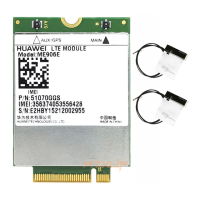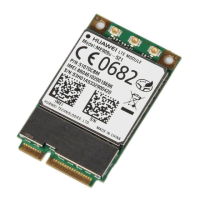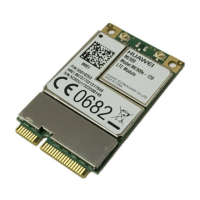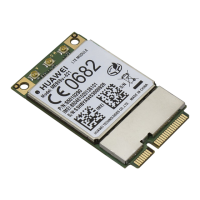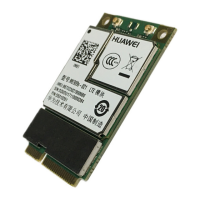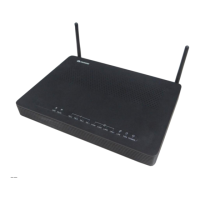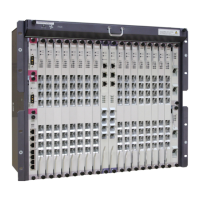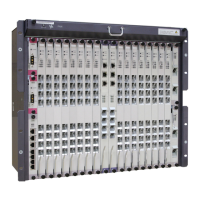Do you have a question about the Huawei ME906s LTE M.2 and is the answer not in the manual?
Introduces the chapter's content and scope.
Details the 75-pin gold finger interface, its layout, and pin definitions.
Introduces the chapter's content and scope.
Provides a summary of the module's key features and specifications.
Introduces the chapter's content and scope.
Describes the 75-pin gold finger interface and pin sequence.
Details the power supply requirements and pin definitions for the module.
Explains control pins like Power_On_Off, RESET#, LED#, W_DISABLE#, etc.
Covers the USB 2.0 high-speed interface specifications and recommended circuits.
Outlines the USIM card interface compliance and signal definitions.
Describes the module's 4 tunable antenna control pins.
Details the 4 configuration pins used for module setup.
Lists reserved pins and advises not to connect them.
Lists pins that are not connected in the module.
Describes the RF antenna connectors and their locations.
Provides guidelines for using coaxial RF connectors and their dimensions.
Introduces the chapter's content and scope.
Lists the RF bands supported by the ME906s module.
Details the test environment and standards for RF measurements.
Provides conducted receive sensitivity and transmit power specifications.
Outlines antenna design indicators, isolation, polarization, and gain.
Discusses interference sources on the user board and how to control them.
Specifies the requirements for antennas used with the ME906s module.
Introduces the chapter's content and scope.
Lists the absolute maximum ratings for the module to prevent damage.
Specifies the normal, extended, and ambient temperature ranges.
Details input power requirements, voltage, and current.
Lists power consumption in various operating modes like sleep, idle, and data transmission.
Presents test conditions and results for various reliability tests.
Provides design comments for Electromagnetic Compatibility and Electrostatic Discharge.
Introduces the chapter's content and scope.
Shows the detailed physical dimensions of the ME906s module.
Describes the packaging methods and quantities for the module.
Introduces the chapter's content and scope.
Guides on how to physically connect the module to a custom board.
Discusses methods to manage heat dissipation for the module.
Explains the procedure for mating and unmating the RF antenna plugs.
Advises on preventing interference with other electronic devices.
Provides safety guidelines concerning medical devices like pacemakers.
Warns about using the device in potentially explosive environments.
Offers safety recommendations for using the device while driving.
Advises on safe usage of the device during air travel.
Highlights potential dangers to children from the device.
Guides on proper disposal and recycling of device materials.
Confirms compliance with the Waste Electrical and Electronic Equipment Directive.
Confirms compliance with the Restriction of Hazardous Substances directive.
Reminds users to observe applicable laws and regulations.
Provides instructions for cleaning and maintaining the device.
Explains the limitations of using the device for emergency calls.
Lists regional approvals and notices.
States compliance with EU directives for radio equipment.
Provides FCC compliance information and warnings for US users.
Introduces the chapter's content and scope.
Details the 75-pin gold finger interface, its layout, and pin definitions.
Introduces the chapter's content and scope.
Provides a summary of the module's key features and specifications.
Introduces the chapter's content and scope.
Describes the 75-pin gold finger interface and pin sequence.
Details the power supply requirements and pin definitions for the module.
Explains control pins like Power_On_Off, RESET#, LED#, W_DISABLE#, etc.
Covers the USB 2.0 high-speed interface specifications and recommended circuits.
Outlines the USIM card interface compliance and signal definitions.
Describes the module's 4 tunable antenna control pins.
Details the 4 configuration pins used for module setup.
Lists reserved pins and advises not to connect them.
Lists pins that are not connected in the module.
Describes the RF antenna connectors and their locations.
Provides guidelines for using coaxial RF connectors and their dimensions.
Introduces the chapter's content and scope.
Lists the RF bands supported by the ME906s module.
Details the test environment and standards for RF measurements.
Provides conducted receive sensitivity and transmit power specifications.
Outlines antenna design indicators, isolation, polarization, and gain.
Discusses interference sources on the user board and how to control them.
Specifies the requirements for antennas used with the ME906s module.
Introduces the chapter's content and scope.
Lists the absolute maximum ratings for the module to prevent damage.
Specifies the normal, extended, and ambient temperature ranges.
Details input power requirements, voltage, and current.
Lists power consumption in various operating modes like sleep, idle, and data transmission.
Presents test conditions and results for various reliability tests.
Provides design comments for Electromagnetic Compatibility and Electrostatic Discharge.
Introduces the chapter's content and scope.
Shows the detailed physical dimensions of the ME906s module.
Describes the packaging methods and quantities for the module.
Introduces the chapter's content and scope.
Guides on how to physically connect the module to a custom board.
Discusses methods to manage heat dissipation for the module.
Explains the procedure for mating and unmating the RF antenna plugs.
Advises on preventing interference with other electronic devices.
Provides safety guidelines concerning medical devices like pacemakers.
Warns about using the device in potentially explosive environments.
Offers safety recommendations for using the device while driving.
Advises on safe usage of the device during air travel.
Highlights potential dangers to children from the device.
Guides on proper disposal and recycling of device materials.
Confirms compliance with the Waste Electrical and Electronic Equipment Directive.
Confirms compliance with the Restriction of Hazardous Substances directive.
Reminds users to observe applicable laws and regulations.
Provides instructions for cleaning and maintaining the device.
Explains the limitations of using the device for emergency calls.
Lists regional approvals and notices.
States compliance with EU directives for radio equipment.
Provides FCC compliance information and warnings for US users.
| Category | LTE Module |
|---|---|
| Form Factor | M.2 |
| Maximum Download Speed | 150 Mbps |
| Maximum Upload Speed | 50 Mbps |
| Supported GSM Bands | 850/900/1800/1900 MHz |
| UMTS DL Speed | 42 Mbps |
| UMTS UL Speed | 5.76 Mbps |
| Operating Voltage | 3.3 V |
| Storage Temperature | -40°C to +85°C |
| LTE Category | Cat 4 |
| Supported LTE Bands | B1/B3/B7/B8/B20 |
| Supported UMTS Bands | B1/B2/B5/B8 |
| Dimensions | 30 x 42 x 2.3 mm |
| Weight | 6g |
